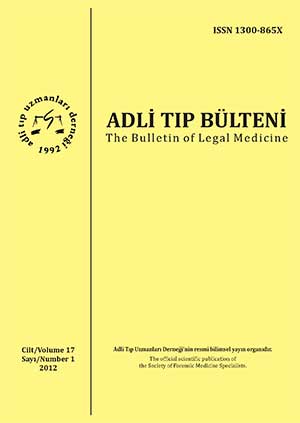Assessment of Deaths due to Carbonmonoxide Poisoning and Autopsied Between 2006-2012 in Elazığ
DOI:
https://doi.org/10.17986/blm.201217114Keywords:
carbonmonoxide, poisoning, autopsyAbstract
Carbonmonoxide (CO) poisonings, that is known as chemical asphyxia, are common in developed and developing countries. It’s becoming more important since it is very common in our country and it is a social and avoidable health problem.
Our study consists of all deaths due to carbonmonoxide poisoning and autopsied by Elazig Fırat University Hospital, Department of Forensic Medicine between 2006 and 2012. Records of a total of 1964 criminal cases who were autopsied between these years were examined and 29 cases who died due to CO poisoning were evaluated for age, sex, month, origin, death time, CO source and carboxyhemoglobin (COHb) values. These 29 criminal cases were constituting 1.47% of 1964 criminal cases who were autopsied within 7 years in Elazig. Mean age of the cases was 31.5±19.5 years, and 19 (65.5%) were men. Origin in 3.4% of all cases was suicide. 31% of deaths occurred in february, 75.9% at home and 79.3% at the moment of the event. CO source was found to be charcoal in 41.4% of cases. Mean COHb level detected in cases was 49.05 ±16.32%.
Although carbonmonoxide poisonings generally occur as a result of avoidable accidents, it is still a social health problem. We suggest that inspections should be increased, warming and heating devices, chimneys, fuels used and ventilation systems should be in accordance with the standards and people should be informed about the weather forecast through media organs in order to avoid these poisonings.
Key words: Carbonmonoxide, poisoning, autopsy.
Downloads
References
Koç S, Özaslan A. Karbonmonoksit Zehirlenmesi. Adli Tıp Kitabı Cilt 1 (Ed: Soysal Z, çakalır C), İstanbul Üniv. Cerrahpaşa Tıp Fakültesi Yayınları, İstanbul, 1999;445-52.
Gül M, Girişgin S, Ak A, Gökalp A. Karbonmonoksit Zehirlenmesi ve hiperbarik oksijen tedavisi. Toksikoloji Dergisi,
; 2(2):27-32.
Kelechi N, Iheagwara A, Stephen R, et al. Myocardial cytochrome oxidase activity is decreased following carbon monoxide exposure. Biochim Biophys Acta 2007;1772:1112–6. DOI: https://doi.org/10.1016/j.bbadis.2007.06.002
Gören S, Tıras¸ çı Y, Üzün UD_I. Banyo ölümlerinin retrospektif de_gerlendirilmesi.Adli Tip Dergisi 2005;19:29-32.
Azmak D. Asphyxial deaths: a retrospective study and review of the literature. Am J Forensic Med Path 2006;27:134-44. DOI: https://doi.org/10.1097/01.paf.0000221082.72186.2e
Buyuk Y, Kocak U. Fire-related fatalities in Istanbul, Turkey: analysis of 320 forensic autopsy cases. J Forensic Leg Med 2009;16:449-54. DOI: https://doi.org/10.1016/j.jflm.2009.05.005
Türkmen N, Akgöz S. Deaths due to carbon monoxide poisonings autopsied in Bursa. Adli Tıp Dergisi 2005;19:20-5.
Uysal C, Celik S, Altuntas A, Kandemir E, Kaya M, Karapirli M, Sezer S, Akyol O. Carbon monoxide-related deaths in Ankara between 2001 and 2011. Inhal Toxicol, 2013; 25(2): 102–106 DOI: https://doi.org/10.3109/08958378.2012.760020
Cantürk N, Bas¸ bulut AZ, Cantürk G, Da_galp R. Ankara’da 2002-2006 yılları arasında Karbonmonoksit zehirlenmeleri otopsi olgularının degerlendirilmesi.Adli Tıp Dergisi 2008;22:25-30.
Karapirli M, Kandemir E, Akyol S, Kantarci M, Kaya M, Akyol O. Forensic and clinical carbon monoxide (CO) poisonings in Turkey:A detailed analysis. Journal of Forensic and Legal Medicine 20 (2013) 95-101 DOI: https://doi.org/10.1016/j.jflm.2012.04.031
Leikin JB, Paloucek FP. Poisoning & Toxicology Compendium with Symptoms Index, Lexi-Comp Inc, Hudson (Cleveland), Ohio 1998: 630-636.
Birincioglu I, Karadeniz H, Teke HY. Fatal poisonings in Trabzon (Turkey) J Forensic Sci 2011;56:660-3. DOI: https://doi.org/10.1111/j.1556-4029.2011.01624.x
Durak D. Karbonmonoksit zehirlenmesine bağlı ölümler. Bursa Devlet Hast. Bült., 1999; 15(2):131-3.
Knight B. Simpson Adli Tıp. Bilimsel ve Teknik Yayınları Çeviri Vakfı. Editör Birgen N. İstanbul 1995:343
Downloads
Published
Issue
Section
License
The Journal and content of this website is licensed under the terms of the Creative Commons Attribution (CC BY) License. The Creative Commons Attribution License (CC BY) allows users to copy, distribute and transmit an article, adapt the article and make commercial use of the article. The CC BY license permits commercial and non-commercial re-use of an open access article, as long as the author is properly attributed.

